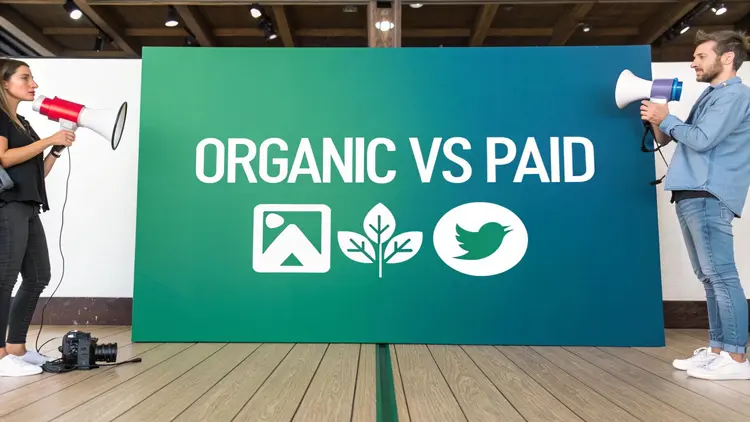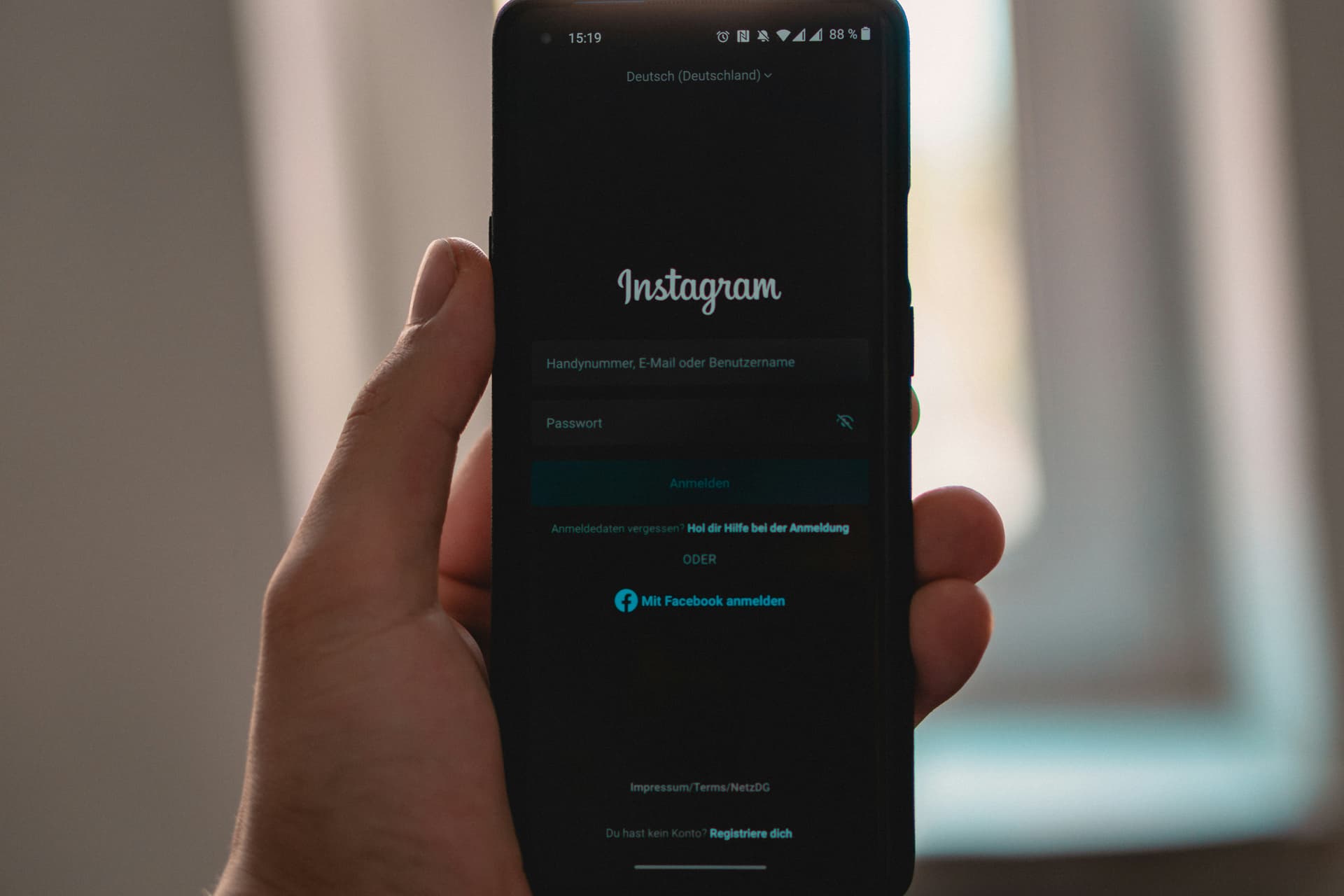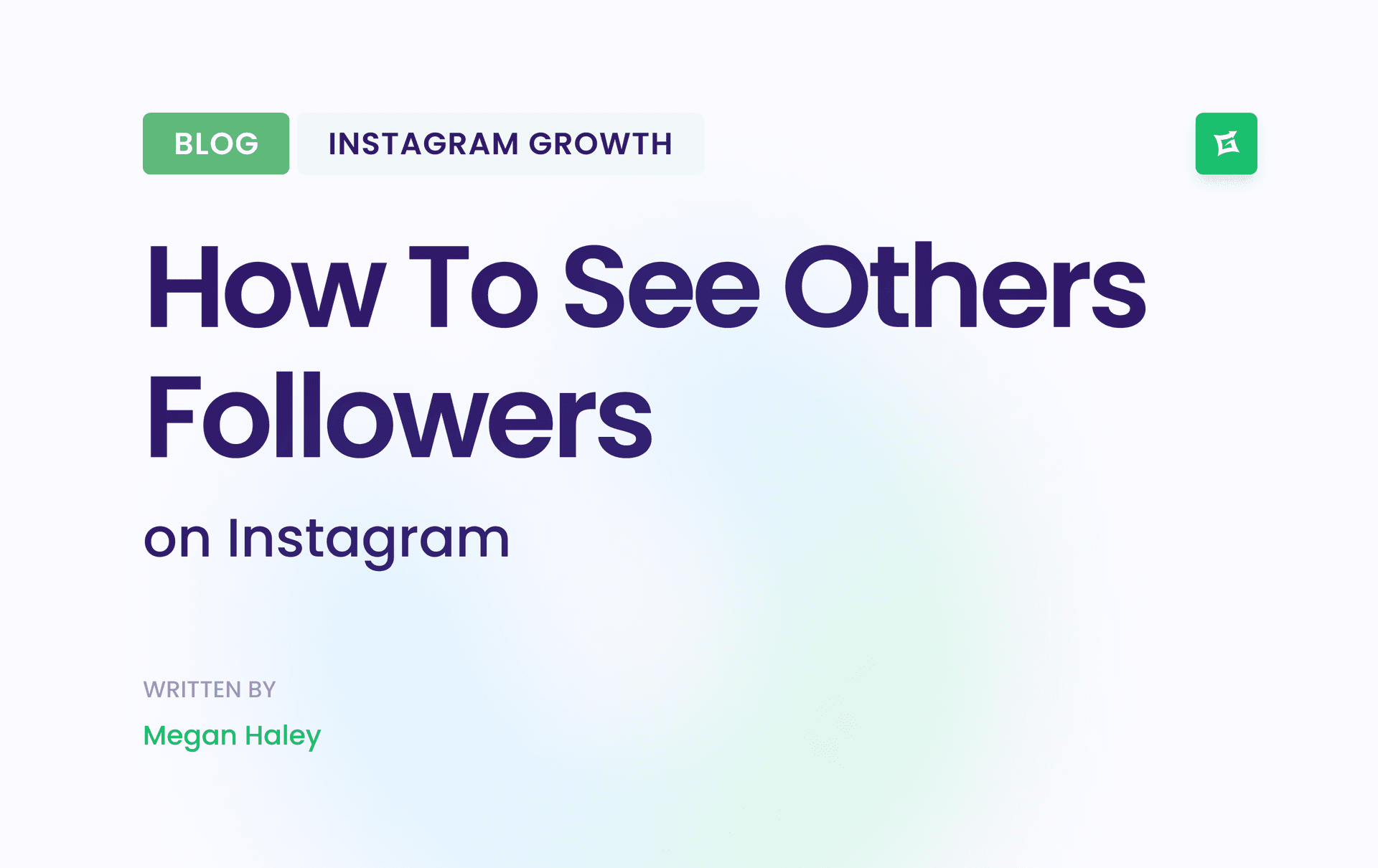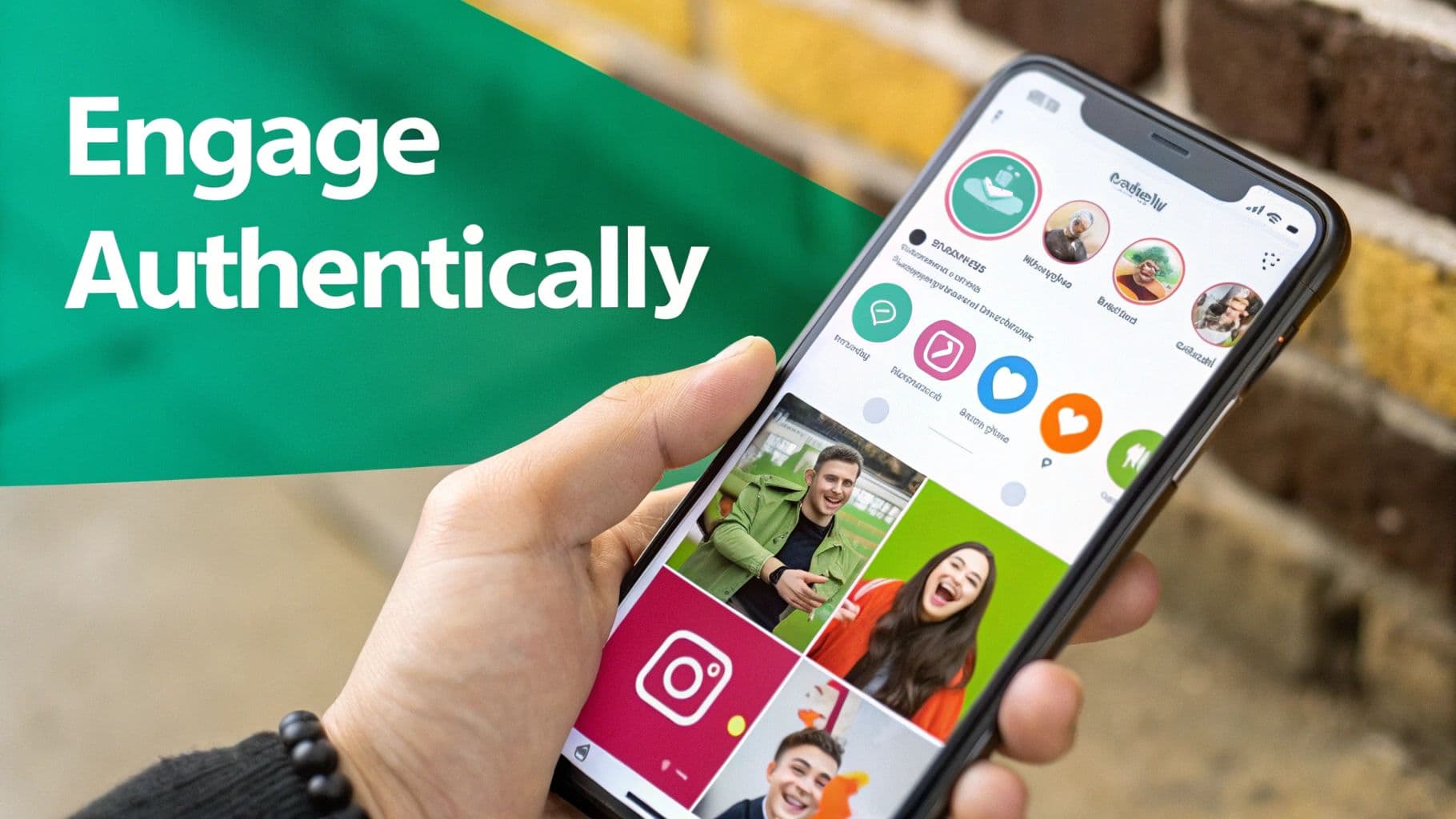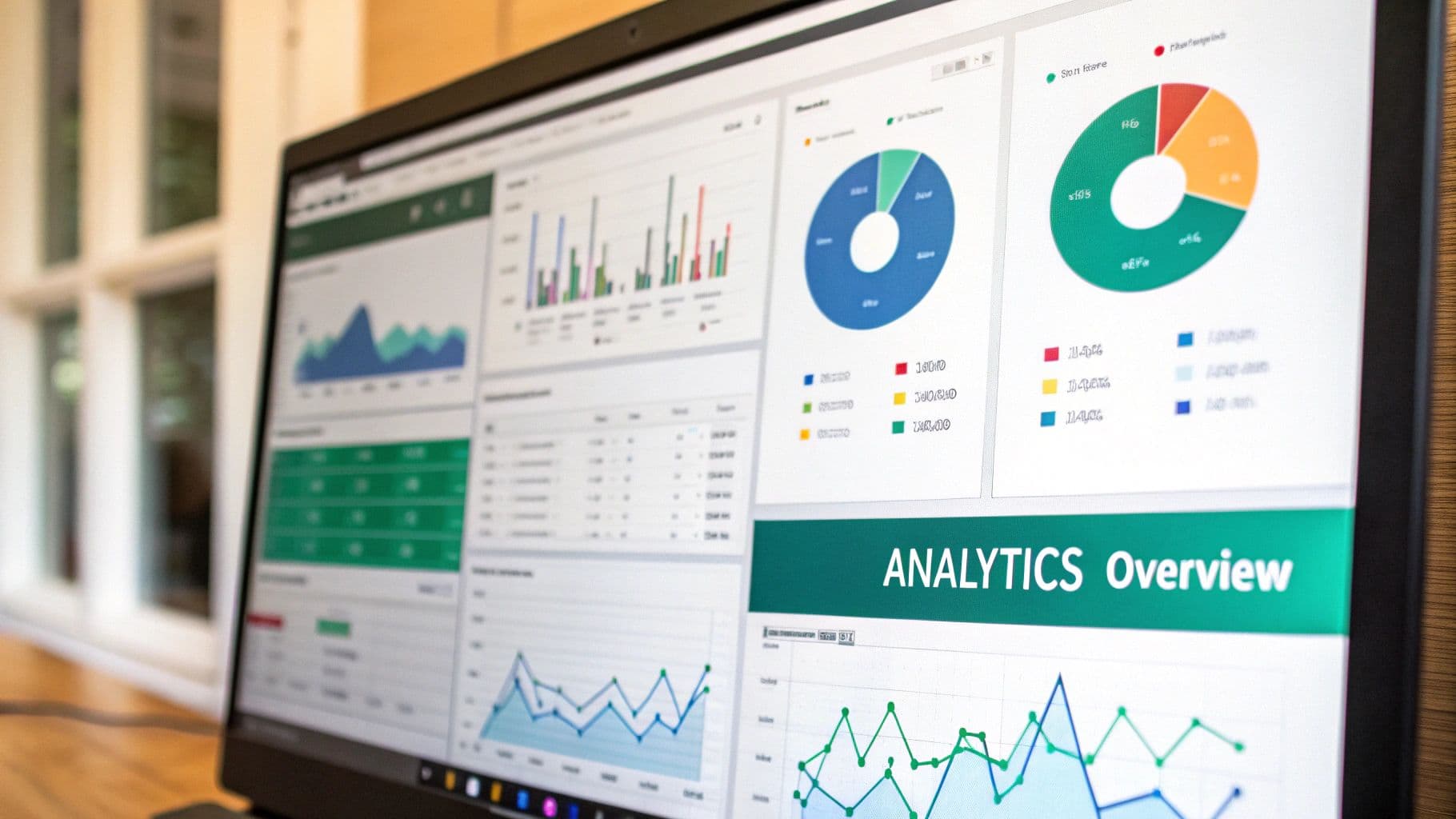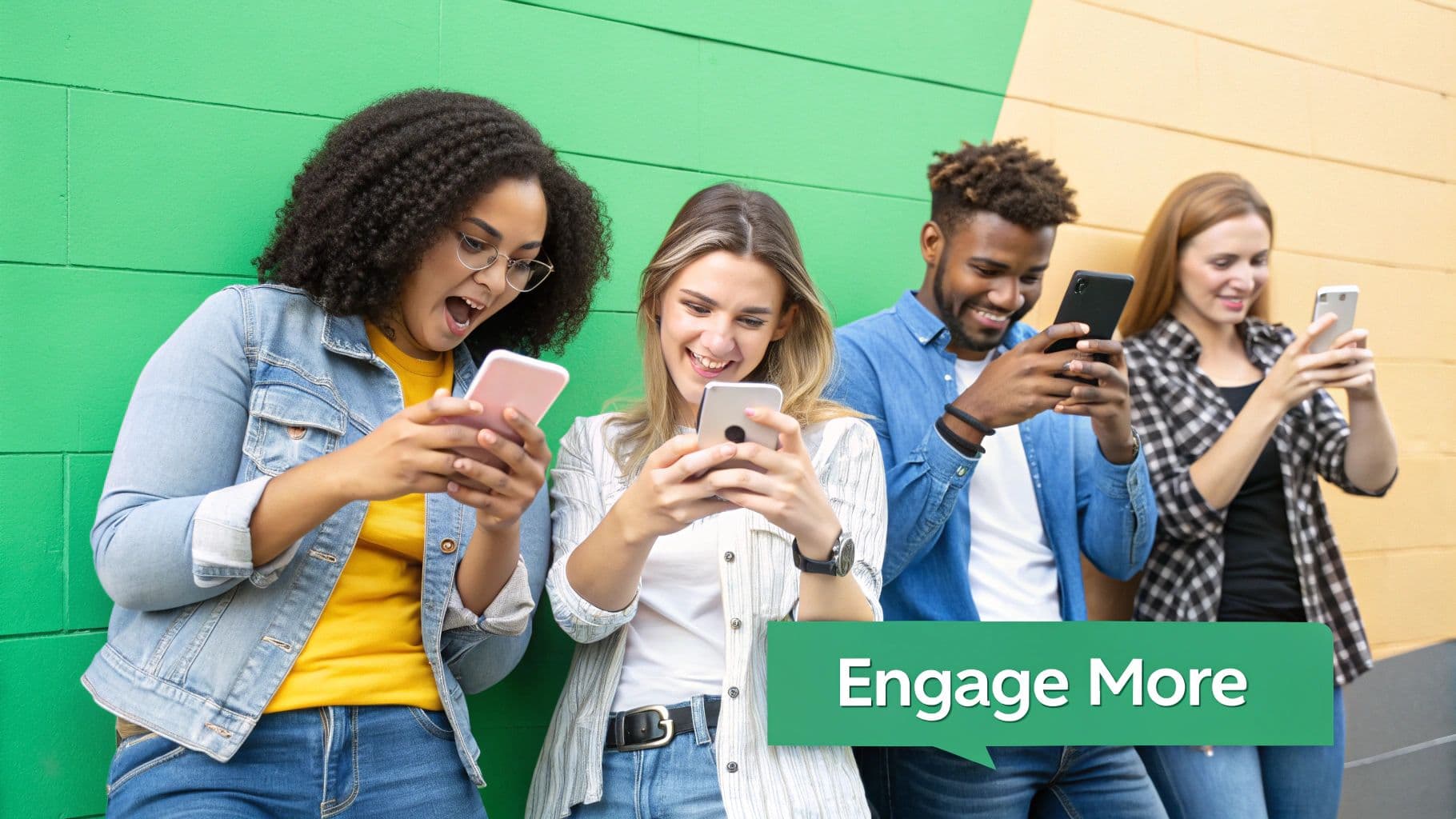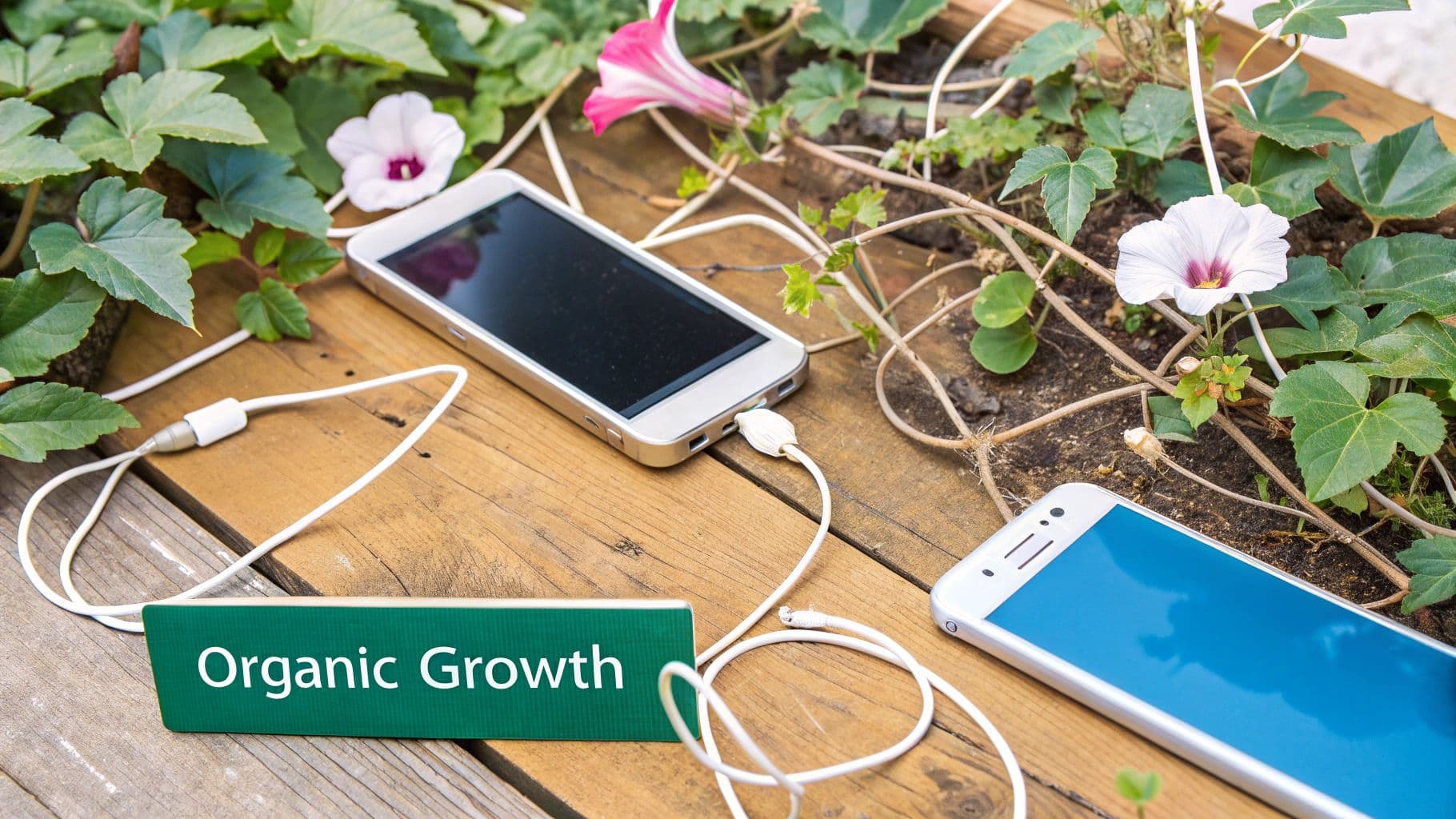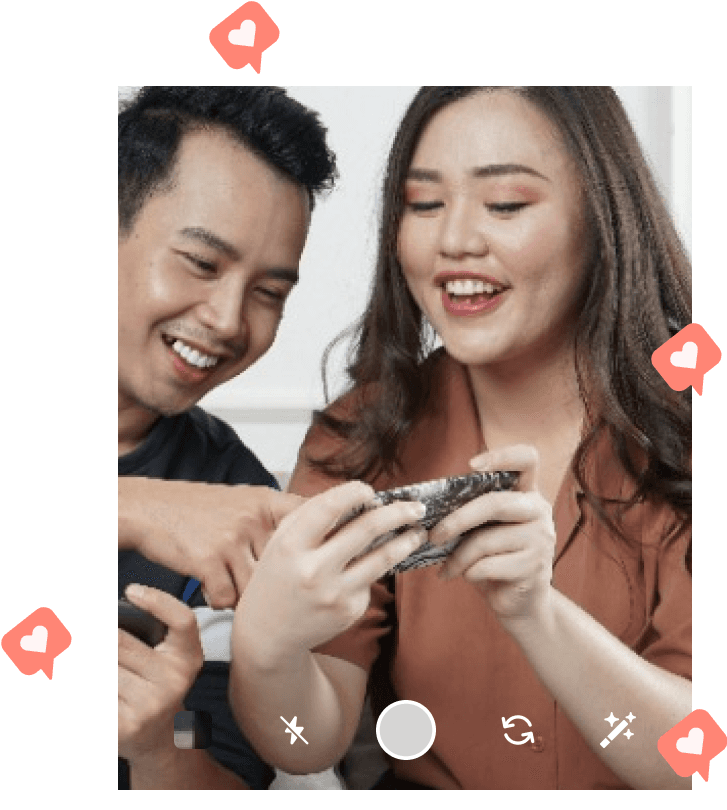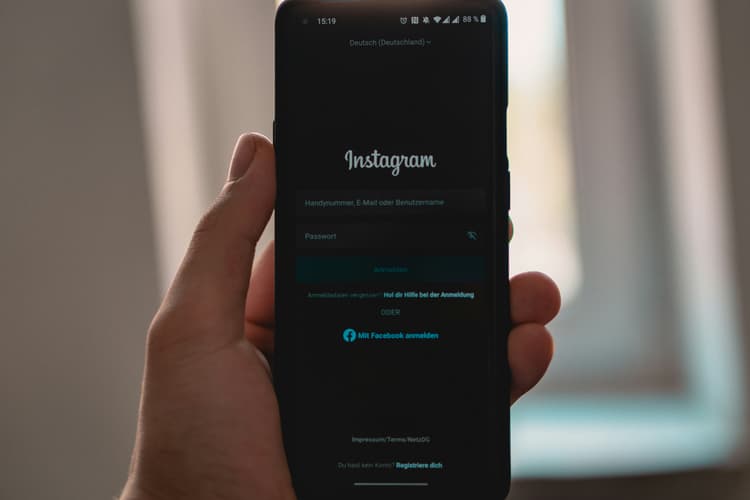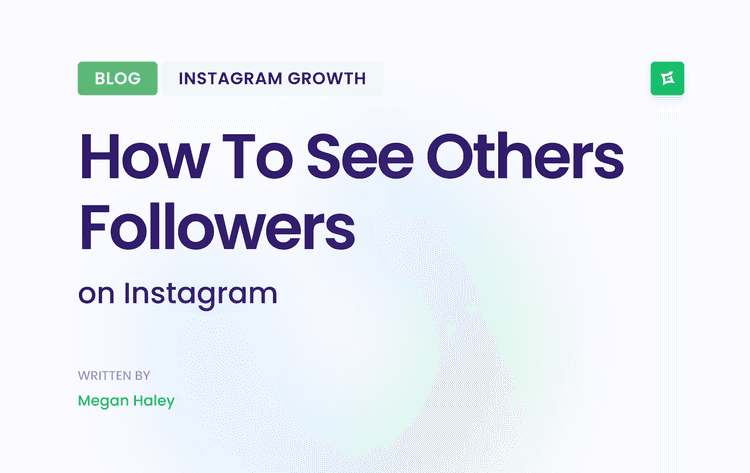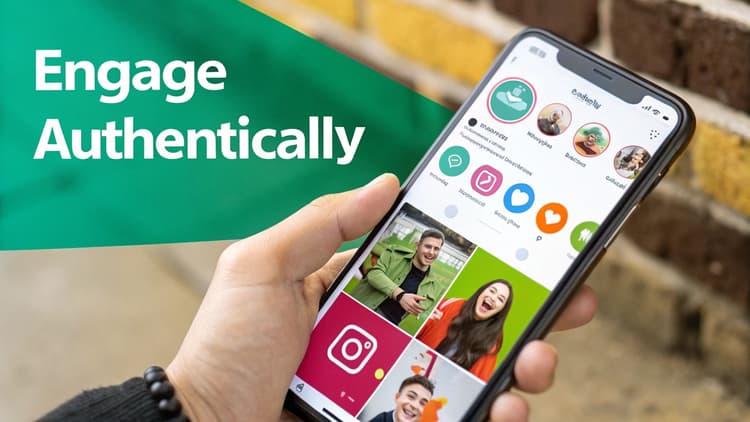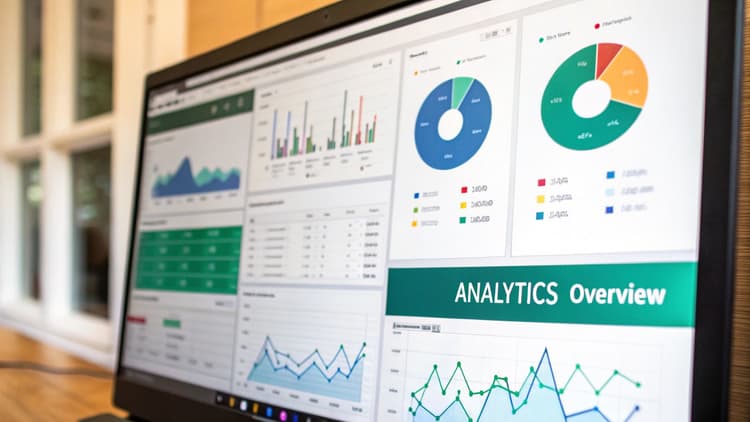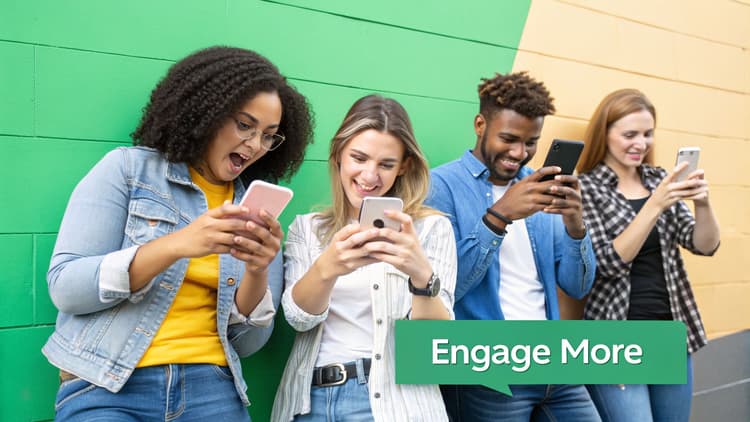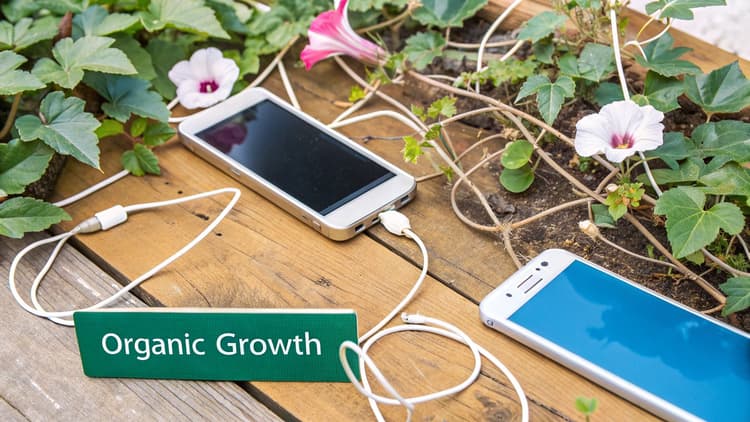Unlocking Social Media Success in 2025
1. Content-First Organic Strategy
In the ongoing debate of organic vs paid social media, the content-first organic strategy is a powerful approach for building a loyal audience and establishing a strong brand awareness. This strategy prioritizes creating high-quality, valuable content that genuinely resonates with your target audience without relying on paid promotion. It's about building an authentic brand voice and fostering a community through consistent, engaging content that encourages natural sharing and interaction. Success with this strategy hinges on understanding your audience's preferences and leveraging platform algorithms to maximize organic reach.

This approach deserves a top spot on any "organic vs paid social media" list because it represents the foundation of genuine online growth. While paid strategies offer immediate visibility, a content-first organic approach builds long-term, sustainable relationships with your audience. This translates to higher credibility and trust – invaluable assets in today's social media landscape.
Features and Benefits:
Emphasis on authentic, valuable content creation: This isn't about churning out clickbait; it's about providing genuine value to your audience.
Algorithm optimization techniques: Understanding how platform algorithms work is crucial for maximizing organic visibility.
Community building through engagement: Active engagement with your audience fosters a sense of belonging and encourages loyalty.
Long-term relationship development: Organic interactions build stronger, more authentic relationships than paid impressions.
Reliance on shareability and virality: Creating compelling content encourages organic sharing, expanding your reach exponentially.
Pros:
Higher credibility and trust with the audience: Authentic content builds trust, a cornerstone of any successful brand.
Lower direct costs compared to paid campaigns: Organic reach doesn't require ad spend, making it a budget-friendly option.
Sustainable long-term results and audience relationships: Organic growth builds a loyal following that sticks around.
Provides valuable audience insights through natural engagement: Organic interactions reveal genuine audience interests and preferences.
Content has an indefinite lifespan and compound value over time: Valuable content continues to attract audiences long after it's published.
Cons:
Slower initial growth and results compared to paid strategies: Organic growth takes time and patience.
Limited reach due to declining organic visibility on many platforms: Algorithm changes can impact organic reach, making it challenging to get seen.
Requires consistent effort and resource commitment: Creating high-quality content regularly demands dedication.
Results can be unpredictable and hard to scale quickly: Organic reach can fluctuate, making it difficult to predict outcomes.
Difficult to target specific demographics precisely: Organic reach is less targeted than paid advertising.
Examples of Success:
Buffer: Known for its valuable content on work culture and productivity, Buffer has built a strong brand identity organically.
REI: The #OptOutside campaign generated massive organic shares by tapping into a shared value.
GoPro: User-generated content showcasing customer adventures fuels GoPro's organic reach.
Glossier: Built primarily through organic Instagram content, Glossier demonstrates the power of community-driven growth.
Actionable Tips:
Post consistently according to a content calendar: Regular posting keeps your audience engaged.
Analyze engagement metrics to refine content strategy: Data-driven insights help optimize your content for better performance.
Respond promptly to comments and messages: Active engagement strengthens community bonds.
Create platform-specific content formats (Stories, Reels, etc.): Tailoring content to platform formats maximizes engagement.
Incorporate trending topics and hashtags strategically: Leveraging trends increases visibility.
When and Why to Use This Approach:
The content-first organic strategy is ideal for:
Influencers seeking organic growth: Building a genuine following based on valuable content.
Small businesses and startups: Establishing a brand presence without significant ad spend.
Brands aiming to boost social media community: Strengthening brand identity and fostering community.
Content creators across various niches: Reaching a wider audience organically.
Marketing agencies and professionals: Offering clients sustainable, long-term social media growth solutions.
By prioritizing valuable content and authentic engagement, the content-first organic strategy offers a powerful path to building a thriving online following and establishing lasting connections with your target audience in the complex landscape of organic vs paid social media.
2. Paid Amplification of Organic Content
In the ongoing debate of organic vs paid social media, a powerful hybrid approach has emerged: paid amplification of organic content. This strategy involves creating high-quality organic content first and then strategically boosting the best-performing posts with paid promotion. This method blends the authenticity and engagement of organic content with the extended reach and targeting capabilities of paid advertising, allowing brands to maximize their return on investment (ROI) by investing only in content proven to resonate with their target audience. This approach deserves its place on this list because it offers a balanced and efficient way to leverage both organic and paid strategies within a social media marketing plan.
How it Works:
The core principle of paid amplification is performance-based selection. Instead of blindly throwing money behind every post, you let your organic audience determine which content is most engaging. Once you identify high-performing organic content (based on metrics like engagement, reach, and shares), you selectively amplify these posts using paid social media advertising. This targeted boosting exposes already successful content to a much wider audience, significantly increasing its visibility and impact.
Features and Benefits:
Performance-based selection for amplification: Data-driven decisions ensure that only the most resonant content receives paid support.
Targeted boosting of already successful content: Reach new audiences who are likely to engage with your brand based on proven organic performance.
A/B testing capabilities for optimization: Refine your paid campaigns by testing different ad creatives and targeting parameters.
Data-driven decision making: Gain valuable insights into which content resonates most effectively, informing future content creation.
Scalable spending based on content performance: Allocate budget flexibly based on the success of individual pieces of content.
Pros:
Maximizes ROI: By promoting only proven content, you minimize wasted ad spend and ensure higher engagement rates.
Extends reach: Expand the visibility of your best content to new audiences who haven't organically discovered your brand.
Maintains authenticity: Leverage the organic feel of your top-performing content while strategically scaling its reach.
Provides performance data: Gather valuable insights into audience preferences to inform future content strategy.
Cost-effective: Compared to purely paid approaches, this method can be significantly more efficient.
Cons:
Requires initial organic traction: You need a sufficient organic audience and engagement to identify winning content for amplification.
More complex to manage: This hybrid approach requires expertise in both organic content creation and paid media management.
Needs ongoing analysis and optimization: Continuous monitoring and adjustments are necessary to maximize campaign performance.
Can still face ad fatigue: Even high-performing content can become stale if overused. Regularly refreshing creatives is essential.
Requires content creation and paid media expertise: A well-rounded skillset is needed to execute this strategy effectively.
Examples of Successful Implementation:
Airbnb: Boosting user-generated content showcasing unique travel experiences.
Dollar Shave Club: Amplifying humorous and engaging organic videos with targeted ads.
Warby Parker: Promoting user-generated content featuring customers wearing their glasses.
HubSpot: Boosting high-performing blog posts and educational content to reach a wider audience of marketing professionals.
Actionable Tips:
Establish clear performance thresholds for amplification: Define specific metrics (e.g., engagement rate, reach) to determine which posts qualify for boosting.
Start with small budgets to test performance before scaling: Experiment with different targeting options and ad creatives with a limited budget before committing significant resources.
Use platform-specific targeting to reach new relevant audiences: Leverage demographic, interest-based, and behavioral targeting to ensure your amplified content reaches the right people.
Refresh creative elements when boosting to prevent ad fatigue: Update visuals, headlines, and copy regularly to maintain audience interest.
Compare performance metrics between organic and amplified versions: Track key metrics to understand the impact of paid amplification on reach, engagement, and conversions.
When and Why to Use This Approach:
Paid amplification of organic content is particularly effective when you have a solid organic visibility but want to expand your reach and maximize the impact of your best content. It's ideal for businesses and influencers seeking a cost-effective way to combine the strengths of organic and paid social media marketing. This method is particularly well-suited for brands aiming to increase brand awareness, drive website traffic, and generate leads. Popularized by industry leaders like HubSpot, Neil Patel, Facebook Business (Meta for Business), and Sprout Social, this hybrid approach is a valuable tool for anyone looking to elevate their social media strategy.
3. Audience Segmentation and Targeted Paid Campaigns
In the ongoing debate of organic vs paid social media, audience segmentation and targeted paid campaigns emerge as a powerful tool, firmly placing paid social media as a critical component of a comprehensive social media strategy. This approach leverages the advanced targeting features of paid social media platforms to deliver highly personalized content to specific audience segments. Instead of casting a wide net and hoping for the best, this strategy focuses on precision, creating tailored campaigns designed to resonate with different demographics, behaviors, interests, or stages in the customer journey. This is a key differentiator in the organic vs paid social media landscape, as organic reach often relies on broader, less targeted content distribution.
How it Works:
The core of this method is to break your target audience into smaller groups of people with similar characteristics, more homogenous groups based on shared characteristics. These segments can be defined by demographics (age, gender, location), behaviors (past purchases, website visits), interests (hobbies, affiliations), or where they are in their buying journey (awareness, consideration, decision). Once these segments are identified, unique ad campaigns are created, each with customized messaging and creative assets specifically designed to appeal to the targeted group. This personalization is difficult to achieve with organic social media alone, highlighting a significant advantage of paid campaigns.
Examples of Successful Implementation:
Spotify: Their personalized end-of-year "Wrapped" campaigns, targeted to individual user listening habits, are a prime example of leveraging user data for hyper-personalized messaging.
Sephora: This beauty retailer uses segmented campaigns targeting different beauty preferences (e.g., skincare enthusiasts vs. makeup lovers) to showcase relevant products and promotions.
Progressive Insurance: They effectively target different demographics with tailored humor, demonstrating how messaging can be adapted for specific audience segments.
Peloton: This fitness brand targets different fitness segments (e.g., beginners vs. experienced cyclists) with specific messaging and motivational content.
Features and Benefits:
Detailed audience segmentation capabilities: Platforms like Facebook Ads offer granular control over audience selection.
Highly customized messaging for each segment: Speak directly to the needs and interests of each group.
Precise control over ad placement and timing: Optimize campaigns for maximum visibility and engagement.
Advanced targeting options (demographics, interests, behaviors): Reach the right people with the right message.
Retargeting capabilities for nurturing prospects: Reconnect with users who have previously interacted with your brand.
Pros and Cons:
Pros:
Higher conversion rates through relevance and personalization: Tailored messaging resonates more effectively.
More efficient ad spend with less waste on uninterested audiences: Target only those most likely to convert.
Ability to test different messages with specific groups: Optimize campaigns based on performance data.
Detailed performance data by segment: Gain insights into which segments are most responsive.
Accelerated results for specific business objectives: Achieve faster growth by focusing on high-potential segments.
Cons:
Higher production costs for multiple creative variations: Creating unique assets for each segment can be expensive.
Requires significant audience research and understanding: Effective segmentation requires in-depth knowledge of your target market.
Privacy regulations are increasingly limiting targeting options: Navigating data privacy regulations can be challenging.
Complex campaign management and optimization: Managing multiple campaigns can be time-consuming.
Potential for audience fatigue if messaging isn't varied: Keep content fresh to avoid losing audience interest.
Tips for Implementation:
Build detailed audience personas before creating campaigns: Understand the motivations, needs, and pain points of each segment.
Use first-party data whenever possible for better targeting: Leverage your existing customer data for more accurate segmentation.
Create message variations that speak directly to segment needs: Address specific pain points and offer tailored solutions.
Test different creative approaches for each segment: Experiment with different visuals and messaging to find what resonates best.
Implement tracking pixels for retargeting opportunities: Reconnect with users who have shown interest in your brand.
Popularized By:
Facebook Ads platform
Jon Loomer (Facebook ads expert)
Molly Pittman (Digital marketing strategist)
LinkedIn Marketing Solutions
When and Why to Use This Approach:
Audience segmentation and targeted paid campaigns are particularly valuable when you want to achieve specific business objectives quickly and efficiently. Whether you're launching a new product, driving sales, or increasing brand awareness, this strategy allows you to focus your resources on the most promising audience segments, maximizing your return on ad spend. While organic social media builds brand equity and community over time, paid campaigns utilizing audience segmentation offer a powerful way to accelerate growth and achieve measurable results, making it an indispensable element in the organic vs paid social media discussion.
4. Influencer Collaboration Strategy (Organic & Paid)
Influencer collaboration is a powerful strategy within both organic and paid social media marketing. It involves partnering with social media influencers to tap into their established audiences. This approach leverages the trust and authentic relationships influencers have cultivated with their followers, leading to more genuine endorsements than traditional advertising. This makes it a valuable tool in the broader context of organic vs paid social media strategies.

Influencer collaborations range from paid sponsorships, where the influencer is compensated for promoting your brand, to organic partnerships built on mutual benefit and shared values. These collaborations can take various forms, including product reviews, giveaways, social media takeovers, and co-created content. You can choose to work with micro-influencers (those with smaller, highly engaged audiences) or macro-influencers (those with large followings). This flexibility allows businesses of all sizes to leverage influencer marketing within their organic vs paid social media strategies.
This strategy deserves a place on this list because it offers a unique blend of organic reach and paid amplification. It allows brands to access highly engaged niche communities and generate both content and distribution in one coordinated effort. This is particularly effective for reaching younger demographics who are often more receptive to influencer recommendations. For example, Daniel Wellington built their entire brand through Instagram influencers, demonstrating the power of this approach. Glossier's ambassador program, which turns customers into micro-influencers, showcases another successful implementation. Similarly, Gymshark's athlete program combines sponsorship with authentic advocacy, creating a powerful synergy between organic vs paid social media strategies. Even established brands like Dunkin' Donuts have leveraged this strategy, partnering with TikTok creator Charli D'Amelio to reach a younger audience.
Pros:
Leverages established trust between influencers and their audiences
Provides access to highly engaged niche communities
Creates more authentic-feeling promotions
Can generate both content and distribution
Particularly effective for reaching younger demographics
Cons:
It can be expensive for well-established influencers
Risk of influencer controversy affecting brand image
Results can be difficult to measure precisely
Declining effectiveness as audiences become more skeptical
Requires careful vetting and relationship management
When planning influencer collaborations, it's essential to follow best practices to ensure successful partnerships and maximize your ROI. For valuable insights and guidance, check out these influencer marketing best practices from JoinBrands. Their Top Influencer Marketing Best Practices for 2025 provide a helpful framework for navigating this evolving landscape.
Tips for Effective Influencer Collaborations:
Focus on authentic fit over follower count.
Develop clear guidelines while allowing creative freedom.
Use unique tracking links or codes to measure performance.
Consider long-term relationships over one-off campaigns.
Test both micro and macro influencers to compare ROI.
By understanding the nuances of influencer collaborations and implementing these tips, businesses can effectively leverage this strategy within their broader organic vs paid social media approach. This can lead to increased brand awareness, improved engagement, and ultimately, a stronger return on investment.
5. Community Building and Engagement-First Approach
When weighing organic vs paid social media strategies, a community-building and engagement-first approach offers a powerful, albeit slower-burning, path to organic growth. This method prioritizes creating and nurturing an active community around your brand rather than simply broadcasting content. It's about fostering two-way conversations, encouraging user participation, and building genuine relationships. This approach is particularly effective for influencers, small businesses, startups, and brands looking to cultivate a loyal following and boost their social media account organically.
Instead of focusing on reach and impressions, this strategy emphasizes meaningful interactions. Features of a successful community-building approach include:
Focus on conversation rather than broadcasting: Ask questions, respond to comments, and actively participate in discussions.
Creation of branded communities or groups: Dedicated spaces (like Facebook Groups or Discord servers) offer a hub for your community to connect.
User-generated content initiatives: Encourage your audience to create content related to your brand through contests, challenges, or simply by sharing their experiences.
Regular interactive content formats (polls, Q&As, lives): These formats boost engagement and provide valuable insights into your audience's preferences.
Community management and moderation practices: Establish clear guidelines and actively moderate discussions to maintain a positive and inclusive environment.
Several brands have successfully implemented this organic vs paid social media strategy:
Peloton: Built a thriving community through hashtags, instructor followings, and online classes that foster a sense of shared experience.
Sephora: Created the Beauty Insider Community, a platform for product discussions, reviews, and beauty advice.
Starbucks: The iconic White Cup Contest encourages users to design their own Starbucks cups, generating massive user-generated content and brand engagement.
Airbnb: Fosters a strong host community through forums and resource sharing, enabling hosts to connect and learn from each other. This community aspect is a key differentiator in the highly competitive travel market.
Pros:
Creates loyal brand advocates who promote organically: A strong community becomes a powerful engine for word-of-mouth marketing.
Provides valuable direct feedback and insights: Direct interaction with your audience provides invaluable feedback on your products, services, and content.
Higher engagement rates and algorithm favorability: Social media algorithms prioritize content with high engagement, giving organic community-building efforts a boost.
More resilient to platform algorithm changes: While paid strategies can be significantly impacted by algorithm shifts, a strong community provides a more stable foundation for growth.
Generates authentic user content that can be repurposed: User-generated content provides a constant stream of authentic material for your social media channels.
Cons:
Resource-intensive for community management: Building and nurturing a community requires dedicated time and effort.
Slower to scale than paid approaches: Organic growth takes time and patience.
Can expose brands to public criticism: Open dialogue can lead to public criticism, requiring careful community management.
Difficult to measure ROI with traditional metrics: The value of community building often extends beyond traditional metrics like clicks and conversions.
Requires consistent attention and genuine interaction: Building trust requires consistent engagement and authentic interaction with your community.
Tips for building a thriving online community:
Create dedicated spaces for community interaction (Facebook Groups, Discord): Provide a central hub for your community to connect and interact.
Develop community guidelines to maintain a positive environment: Establish clear expectations for behavior to foster a respectful and inclusive community.
Recognize and reward active community members: Show appreciation for your most engaged members to encourage continued participation.
Schedule regular live events to foster real-time connection: Live sessions provide a valuable opportunity to connect with your audience in a more personal and engaging way.
Train team members in community management best practices: Equip your team with the skills and knowledge to effectively manage and nurture your online community.
This community-building approach, popularized by brands like Peloton, Glossier, Lululemon, and community-building platforms like Community Club, represents a powerful alternative to purely paid social media strategies. By prioritizing genuine engagement and relationship building, brands can cultivate a loyal following, gain valuable insights, and establish a resilient presence in the ever-evolving social media landscape. This method deserves a place on this list because it offers a sustainable, long-term strategy for organic growth that complements and often surpasses the impact of paid advertising, particularly when choosing between organic vs paid social media for long-term brand building.
6. Platform-Specific Optimization Strategy
In the ongoing debate of organic vs paid social media, a platform-specific optimization strategy emerges as a critical factor for success. This approach recognizes the individuality of each social media platform, acknowledging that a one-size-fits-all approach simply won't cut it. Instead, it emphasizes creating content tailored to each platform's unique algorithms, audience behaviors, and content preferences. This applies to both organic posting and paid promotion, maximizing the potential of each.
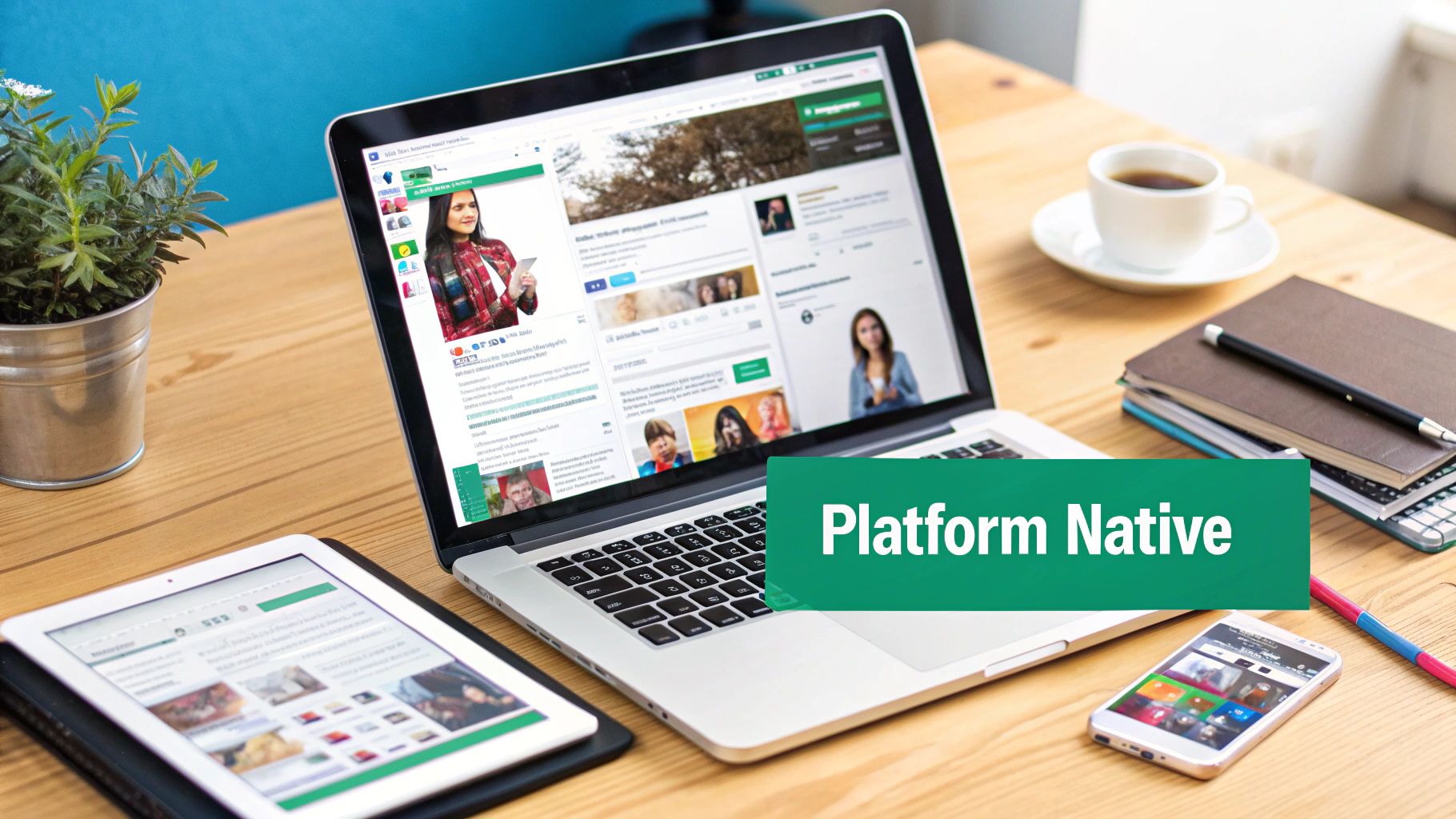
This strategy involves creating native content, meaning content specifically designed for a particular platform. Think short-form, engaging videos for TikTok, visually compelling imagery for Instagram, and professional, long-form articles for LinkedIn. It also means leveraging platform-specific features like Instagram Reels, Stories, Twitter Spaces, or LinkedIn articles. By understanding how each platform's algorithm works, you can optimize posting times and content formats (aspect ratios, video lengths, etc.) to maximize reach and engagement. Even community management should be tailored – the tone and style of interaction on Twitter will differ significantly from LinkedIn.
This approach deserves its place on this list because it bridges the gap between organic and paid social media efforts. By optimizing for each platform, you improve organic reach and create more effective paid campaigns. This resonates strongly with businesses, influencers, and content creators seeking a holistic social media strategy.
Examples of Successful Implementation:
Duolingo: Their TikTok strategy, filled with humorous skits and trends, contrasts sharply with their more informational and professional LinkedIn approach.
National Geographic: Their stunning visual storytelling is adapted for each platform. On Instagram, they leverage high-quality images and captivating captions, while on Twitter, they condense information into concise, impactful tweets, often accompanied by striking visuals.
Wendy's: Known for their sassy and engaging Twitter persona, they adapt their voice to a more family-friendly tone on Facebook, reflecting the different audience demographics and platform cultures.
Pros:
Higher engagement rates through platform-native content
Improved algorithm performance and organic reach
More authentic presence on each platform
Ability to reach different audience segments across platforms
Maximizes both organic and paid performance
Cons:
Resource-intensive to create platform-specific content
Requires specialized knowledge of multiple platforms
More complex to manage and measure across platforms
Constant adaptation is needed as platforms evolve
Difficult to maintain a perfectly consistent brand voice across varied formats
Actionable Tips:
Research is Key: Study top-performing content on each platform before creating your own.
Plan Ahead: Create platform-specific content calendars to stay organized.
Brand Consistency: Adapt messaging while maintaining core brand values and recognition.
Analyze and Optimize: Use platform-specific analytics to continuously optimize content and strategies.
Specialized Teams: Consider having specialized team members for different platforms to leverage their expertise.
When and Why to Use This Approach:
This strategy is crucial for anyone serious about maximizing their social media community, whether using organic or paid methods. It is particularly relevant for:
Influencers seeking organic growth: Reaching the right audience with the right content is crucial for organic growth.
Small businesses and startups: Maximizing limited resources requires strategic platform selection and optimization.
Brands aiming to boost social media presence: A cohesive yet platform-specific strategy strengthens brand identity and reach.
Content creators across various niches: Tailoring content increases engagement and builds a loyal following.
Marketing agencies and professionals: Understanding platform nuances is essential for effective client campaigns.
Thought leaders like Gary Vaynerchuk have long championed the platform-native content approach. Tools like Later (for scheduling) and Hootsuite (for platform management and education) can help implement this strategy. Duolingo's success, particularly on TikTok, serves as a compelling case study. By embracing a platform-specific optimization strategy, you can navigate the complex world of organic vs paid social media effectively and achieve meaningful results.
7. Data-Driven Testing and Optimization
In the dynamic world of organic vs paid social media, data-driven testing and optimization emerge as a critical strategy for success. This approach applies scientific testing methods to both organic and paid social media efforts, moving beyond gut feelings and assumptions to make informed decisions based on concrete evidence. It involves systematic A/B testing, rigorous data analysis, and continuous optimization based on key performance metrics. This allows you to refine your strategy, maximize your ROI, and achieve sustainable growth on social media.
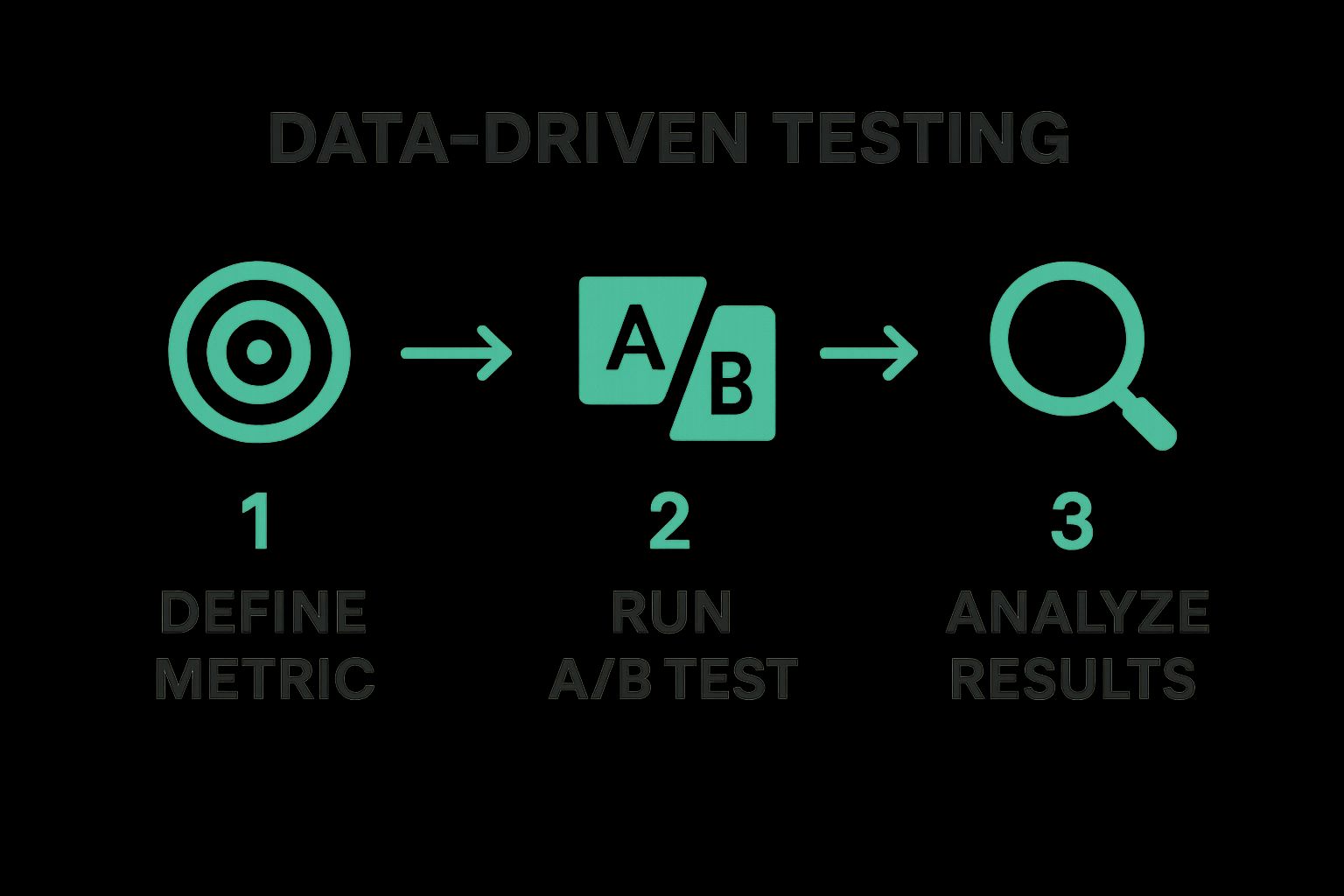
The infographic above visualizes the cyclical process of data-driven optimization. It begins with establishing a hypothesis about what will improve performance, followed by designing an experiment (like an A/B test). Then, data is collected and analyzed to determine the winning variation. Finally, this winning variation is implemented, and the cycle begins anew with further hypotheses and testing. This continuous loop drives incremental improvements over time.
This data-driven approach is essential for anyone serious about succeeding in the competitive social media landscape, whether focusing on organic reach or paid campaigns. It provides the necessary insights to understand what truly resonates with your audience and how to continuously improve your results.
Features of data-driven testing and optimization include systematic A/B testing frameworks, performance analysis using advanced analytics, iterative optimization based on results, multivariate testing capabilities, and attribution modeling to understand the impact of various touchpoints. These features empower you to dissect your social media performance and identify areas for improvement.
Pros:
Eliminates guesswork: Decisions are based on evidence, not intuition.
Continuously improves ROI: Refining your strategy based on data leads to better returns over time.
Provides broader marketing insights: Data from social media can inform your overall marketing strategy.
Allows for personalization: Data insights enable you to tailor your content and campaigns for specific audience segments.
Reduces wasted resources: By identifying ineffective approaches, you can avoid spending time and money on strategies that don't work.
Cons:
Requires analytical expertise: Interpreting data and designing effective tests requires some analytical skills.
Needs appropriate tools: Specialized tools and platforms are often necessary for A/B testing and in-depth analysis.
Can slow down content production: The testing phase can sometimes add time to your content creation process.
May prioritize metrics over creative intuition: Over-reliance on data can sometimes stifle creativity.
Requires sufficient sample sizes: Meaningful results require enough data for statistical significance.
Examples of Successful Implementation:
Netflix: Extensively A/B tests thumbnail images to optimize click-through rates and content consumption.
BuzzFeed: Employs data-driven headline testing to maximize engagement and virality.
Spotify: Uses algorithms and data to personalize content recommendations for individual users.
Amazon: Constantly optimizes product promotions and recommendations based on user behavior.
Actionable Tips:
Test one variable at a time: This isolates the impact of each change and provides clear results.
Establish clear success metrics: Define what you want to achieve before you start testing (e.g., increased engagement, higher click-through rates).
Use statistical significance calculators: Ensure your results are valid and not due to random chance.
Create a systematic testing calendar: Schedule regular testing to continuously optimize your strategy.
Document test results: Keep a central repository of your test results to track progress and identify trends.
When and Why to Use This Approach:
Data-driven testing and optimization are valuable for anyone managing organic or paid social media campaigns. It is particularly important when:
Launching new campaigns: Testing helps you identify the most effective messaging and targeting from the start.
Optimizing existing campaigns: Continuously testing allows you to refine your approach and improve performance over time.
Understanding audience behavior: Data analysis provides insights into what resonates with your target audience.
Maximizing ROI: Testing helps you identify the most efficient use of your budget and resources.
Data-driven testing and optimization deserve their place on this list because they provide a structured, evidence-based approach to social media marketing. By embracing this methodology, businesses, influencers, and content creators can move beyond guesswork and build a truly effective social media strategy. This approach is popularized by industry leaders like Neil Patel and facilitated by platforms like Optimizely and tools like Facebook's Experiments feature. This approach is crucial for anyone looking to navigate the complexities of organic vs paid social media and achieve sustainable growth.
8. Full-Funnel Social Media Strategy
A full-funnel social media strategy is a comprehensive approach that leverages both organic and paid social media tactics across all stages of the customer journey. This method recognizes that a potential customer's interaction with your brand evolves from initial awareness to eventual purchase and beyond. By mapping specific content and promotional strategies to each stage of this journey – awareness, interest, consideration, conversion, and retention – you can create a more seamless and effective approach to social media marketing. This is particularly important when comparing organic vs paid social media, as each plays a distinct role within the larger funnel.
How It Works:
The core of a full-funnel strategy lies in understanding your target audience's behavior at each stage. For instance, during the awareness stage, organic content focusing on brand building and educational value might be prioritized. As prospects move into the consideration phase, paid social media advertising showcasing specific product features and benefits can become more effective. Finally, in the conversion stage, retargeting campaigns and special offers through paid social can encourage final purchase decisions. Even after conversion, organic community building and loyalty programs can drive retention.
Features of a Full-Funnel Strategy:
Mapped Content and Tactics to Customer Journey Stages: Tailored content for each stage, ensuring relevance and maximizing impact.
Integration of Organic and Paid Approaches by Funnel Stage: Strategic use of both organic reach and paid amplification where they are most effective.
Sequential Targeting and Remarketing Flows: Guiding prospects through the funnel with targeted messaging and follow-up based on previous interactions.
Different Content Formats for Different Funnel Positions: Utilizing diverse formats (videos, blog posts, infographics, interactive content) to cater to audience preferences at each stage.
Cross-Platform Journey Orchestration: Delivering a consistent brand experience across different social media platforms.
Pros:
Creates a Seamless Customer Experience: Guides the customer through a cohesive journey, fostering trust and loyalty.
Optimizes Resources: Uses the most appropriate tactics at each stage, maximizing ROI for both organic and paid efforts.
Increases Overall Conversion: Addresses all stages of the funnel, nurturing leads, and minimizing drop-off.
Provides Framework for Measuring Impact at Each Stage: Allows for granular analysis and optimization of the entire customer journey.
Allows for Precision in Addressing Conversion Bottlenecks: Identifies and rectifies weaknesses in specific stages of the funnel.
Cons:
Complex to Implement and Manage Across Teams: Requires coordination between organic and paid social media teams.
Requires Sophisticated Tracking and Attribution: Needs robust analytics to measure the effectiveness of different tactics.
Needs Significant Content Variety for Different Stages: Demands a consistent output of diverse content formats.
More Expensive to Maintain than Single-Stage Approaches: Requires investment in both organic content creation and paid advertising.
Challenging to Coordinate Timing Across Funnel Stages: Ensuring consistent messaging and timely delivery across all touchpoints can be complex.
Examples of Successful Implementation:
HubSpot: Utilizes inbound marketing methodology across social channels, creating valuable content that attracts and nurtures leads throughout the funnel.
Shopify: Employs a defined merchant acquisition funnel, from awareness through social media advertising to activation and ongoing support.
Adobe: Leverages B2B marketing tactics, from thought leadership content on social media to driving product trials through targeted advertising.
Dollar Shave Club: Mastered viral awareness campaigns and translated that initial buzz into subscription conversions through targeted social media marketing.
Tips for Implementation:
Map out your entire customer journey before planning content: Understand your audience's path to purchase.
Use different success metrics for different funnel stages: Track awareness (reach, impressions), engagement (likes, shares, comments), and conversions (clicks, purchases).
Implement proper tracking to follow users through the funnel: Utilize UTM parameters and platform analytics to understand customer behavior.
Coordinate organic and paid teams around funnel objectives: Ensure consistent messaging and strategy across all teams.
Create remarketing segments based on engagement with specific funnel stages: Target users who have interacted with specific content with tailored follow-up messaging.
Why This Deserves Its Place on the List:
In the context of organic vs paid social media, a full-funnel strategy provides the framework for strategically integrating both approaches. It highlights that neither organic nor paid efforts exist in isolation; rather, their combined power is maximized when deployed strategically across the customer journey. For anyone looking to build a comprehensive and effective social media strategy, understanding the full-funnel approach is crucial. It provides a roadmap for optimizing resources, maximizing ROI, and ultimately driving business growth. This approach caters to influencers, small businesses, brands, content creators, and marketing agencies alike, offering a structured methodology for leveraging the full potential of social media. Popularized by industry leaders like HubSpot, Digital Marketer, and Facebook Business, the full-funnel approach is a proven strategy for sustainable growth and success in the competitive social media landscape.
Organic vs Paid Social Media Strategies Comparison
Strategy Overview
The strategy focuses on a content-first organic approach, emphasizing consistent efforts to showcase expertise.
Organic Content Strategy
Effort: Medium (requires consistent content creation).
Best for: Brands prioritizing credibility and long-term audience relationships.
Advantages: Builds high trust, incurs low costs, and delivers sustainable value.
Paid Amplification of Organic Content
Effort: Moderate to High (requires content + paid media management).
Best for: Brands with strong organic content looking to scale efficiently.
Advantages: Combines scalable reach with optimized ROI while maintaining authenticity.
Audience Segmentation & Targeted Paid Campaigns
Effort: High (needs detailed segmentation and creative variations).
Best for: Campaigns requiring precise demographic targeting (e.g., personalized ads).
Advantages: Drives faster conversions, efficient spend, and provides detailed insights.
Influencer Collaboration Strategy
Effort: Medium to High (partnership management).
Best for: Brands targeting younger audiences or niche markets.
Advantages: Leverages influencer trust and authentic community reach.
Community Building & Engagement-First Approach
Effort: Medium (ongoing interaction/moderation).
Best for: Brands aiming for deep customer relationships and user-generated content.
Advantages: Cultivates loyal advocates and generates valuable feedback.
Platform-Specific Optimization
Effort: High (requires multi-platform expertise).
Best for: Brands active across multiple platforms needing tailored content.
Advantages: Boosts engagement through native formats and authentic following.
Data-Driven Testing & Optimization
Effort: High (analytical tools/skills needed).
Best for: Data-centric teams optimizing organic/paid performance.
Advantages: Evidence-based decisions and improved ROI.
Full-Funnel Social Media Strategy
Effort: Very High (complex cross-funnel coordination).
Best for: Businesses integrating marketing across all customer journey stages.
Advantages: Seamless customer experience, higher conversions, and precise resource allocation.
Crafting Your Winning Social Media Strategy
Successfully navigating the dynamic world of social media requires a nuanced understanding of both organic and paid strategies. This article has explored the key differences between organic vs paid social media, covering everything from content-first organic approaches and paid amplification to influencer collaborations and platform-specific optimization. We've also highlighted the critical role of data-driven testing, audience segmentation, and building a full-funnel strategy. The most important takeaway? There's no one-size-fits-all solution. Your ideal approach will depend on your specific goals, resources, and target audience.
Mastering these concepts is crucial for building a thriving online community. Whether you're an influencer seeking organic growth, a small business aiming to boost brand awareness, or a marketing agency managing multiple clients, understanding the interplay of organic vs paid social media empowers you to connect with your audience effectively, drive meaningful engagement, and ultimately achieve your business objectives. By consistently analyzing your data and adapting your strategies, you can stay ahead of the curve and maximize your impact in the ever-evolving social media landscape.
Remember, building a strong social media presence is a marathon, not a sprint. Embrace experimentation, stay informed about platform changes, and prioritize genuine connection with your audience. Looking to organically amplify your Instagram followers? Gainsty offers an AI-powered solution that leverages authentic growth methods to safely expand your following and increase organic reach. Visit Gainsty today and discover how data-driven strategies can help you achieve real, organic growth without resorting to paid shortcuts.
